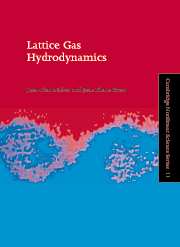Book contents
- Frontmatter
- Contents
- Preface
- Chapter 1 Basic ideas
- Chapter 2 Microdynamics: general formalism
- Chapter 3 Microdynamics: various examples
- Chapter 4 Equilibrium statistical mechanics
- Chapter 5 Macrodynamics: Chapman–Enskog method
- Chapter 6 Linearized hydrodynamics
- Chapter 7 Hydrodynamic fluctuations
- Chapter 8 Macrodynamics: projectors approach
- Chapter 9 Hydrodynamic regimes
- Chapter 10 Lattice gas simulations
- Chapter 11 Guide for further reading
- Appendix Mathematical details
- References
- Author index
- Subject index
Chapter 4 - Equilibrium statistical mechanics
Published online by Cambridge University Press: 13 October 2009
- Frontmatter
- Contents
- Preface
- Chapter 1 Basic ideas
- Chapter 2 Microdynamics: general formalism
- Chapter 3 Microdynamics: various examples
- Chapter 4 Equilibrium statistical mechanics
- Chapter 5 Macrodynamics: Chapman–Enskog method
- Chapter 6 Linearized hydrodynamics
- Chapter 7 Hydrodynamic fluctuations
- Chapter 8 Macrodynamics: projectors approach
- Chapter 9 Hydrodynamic regimes
- Chapter 10 Lattice gas simulations
- Chapter 11 Guide for further reading
- Appendix Mathematical details
- References
- Author index
- Subject index
Summary
In Chapter 2, we established the equations governing the microscopic dynamics of the lattice gas. This microscopic dynamics provides the basics of the procedure for constructing automata simulating the behavior of fluid systems (see Chapter 10). However, in order to use LGAs as a method for the analysis of physical phenomena, we must go to a level of description which makes contact with macroscopic physics. Starting from a microscopic formalism, we adopt the statistical mechanical approach.
We begin with a Liouville (statistical) description to establish the lattice Liouville equation which describes the automaton evolution in terms of configuration probability in phase space. We then define ensemble-averaged quantities and, in particular, the average population per channel whose space and time evolution is governed by the lattice Boltzmann equation (LBE), when we neglect pre-collision correlations as well as post-collision re-correlations (Boltzmann ansatz). The LBE will be seen to play in LGAs the same crucial role as the Boltzmann equation in continuous fluid theory; an H-theorem follows from which the existence of a Gibbsian equilibrium distribution is established when the semi-detailed balance is satisfied.
The Liouville description
In Chapter 2 we introduced the notion of Boolean field ni(r*, t*) to obtain a complete microscopic description of the time-evolution of lattice gases. We also introduced the phase space Γ which is the set of all possible Boolean configurations of the whole lattice.
- Type
- Chapter
- Information
- Lattice Gas Hydrodynamics , pp. 68 - 108Publisher: Cambridge University PressPrint publication year: 2001

